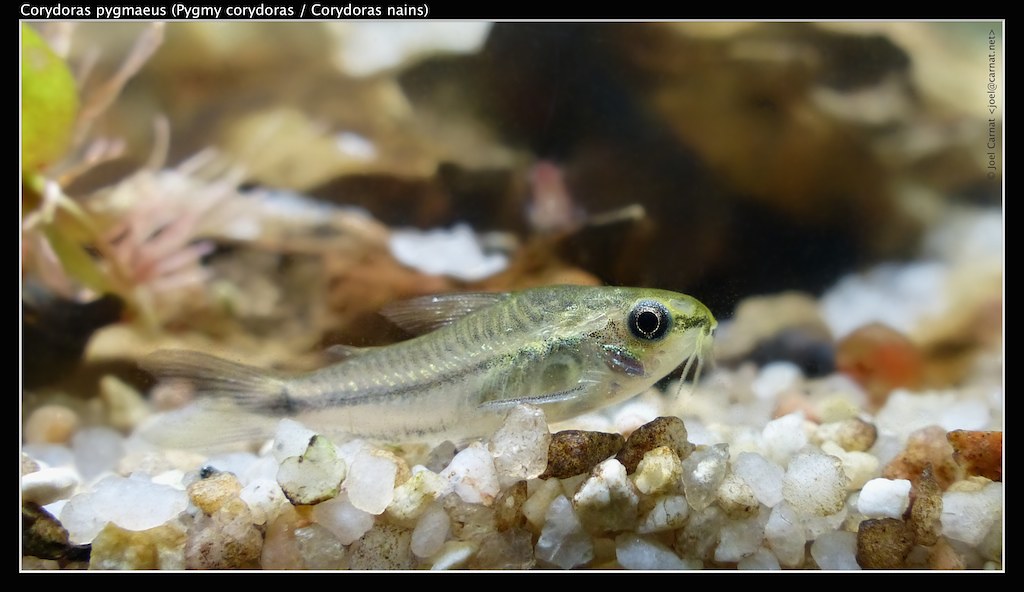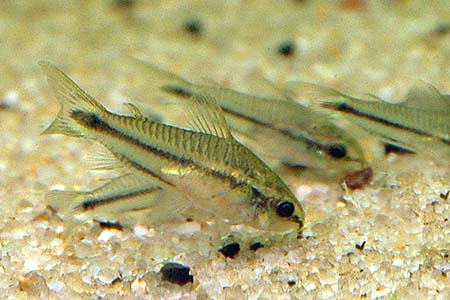Pygmy Corydoras
The Pygmy Cory, Corydoras pygmaeus, is one of the three marshalled dwarf catfish species utilized in fishkeeping. For some time, Pygmy corys were classified together with other dwarf types belonging to the same genus. Their popularity among experienced aquarists and beginners has seen them quickly become a favorite in many pet stores, however, occasionally you may encounter incorrect labels for this particular species.
- Experience Level: Beginner
- Hardiness: Hardy
- Minimum Tank Size: 10 gal (40L)
- Maximum Size: 1 inches (2.5 cm)
- Temperament: Peaceful
- Temperature: 72 – 79° F (22 – 26° C)
- pH Range: 6.5 – 7.5
- Water Hardness: 6 – 10 dGH
- Diet: Omnivore
Table of Contents
Introduction
Size and Appearance
Care Guide
Tank Mates
Diet and Feeding
Breeding
Under the genus corydoras, new subtypes of catfish continually emerge, among these is the Pygmy corydoras. The name derives from the Latin language, ‘pygmaeus,’ which means ‘dwarf’ which is very apt since this species represents some of the tiniest freshwater fish in the fishkeeping world. The Pygmy cory, or Corydoras pygmaeus, are frequent inhabitants of the South American continent, primarily found in the Madeira, Nanay, and Aguarico rivers. They prefer warm, turbid environments that teem with other aquatic life.
This species was initially described by German scientist, Joachim Knaack, in1966. Initially, enthusiasts presumed the only miniature species of corydoras was the Tail-Spot cory, otherwise known as corydoras hastatus. Over the years, however, experts have been able to differentiate between Pygmy catfish and corydoras hastatus due to their striking similarities, advancing the understanding that various species had formerly been incorrectly identified.
Size and Appearance
Emanating from its name, the Pygmy corydoras catfish is indeed small, with an approximate length between 0.75 and 1 inch. Females tend to be slightly lengthier and seemingly wider, especially during their egg-carrying periods. This size difference is the only discernible factor between male and female Pygmy corys.
These tiny catfishes have a body shape characteristic of a teardrop, similar to others of their genus. Their under-turned mouths are equipped with barbels used for navigation and scavenging food. Their distinct color structure displays a silver-toned body with a pronounced black line running horizontally from the snout to the tail. They feature a white belly and bear a metallic gloss above the stripes.
Care Guide
- Minimum Tank Size: 10 gal (40 L)
- pH Range: 6.5 – 7.5
- Water Hardness: 6 – 10 dGH
- Temperature: 72 – 79° F (22 – 26° C)
- Lighting: Low to Moderate, diffused lighting
- Substrate: Fine sand/gravel
- Brackish: No
- Water Flow: Weak/Low
- Tank Region: Mainly Bottom
The Pygmy cory is sensitive to fluctuating water conditions. High levels of ammonia and nitrates can stress them, making them more vulnerable to diseases. Delivering weekly partial water changes can help maintain water quality. Despite their exposure to common aquatic health issues, Pygmy corys are thought to be more susceptible to a condition identified as red blotch disease.
Signified by unpleasant-looking lesions spreading along the belly and flank, diagnosis of red blotch disease is not straightforward. The progression of the disease is usually slow, with symptoms emerging over weeks or months, leading to the final demise of the fish. The exact pathogens responsible for this disease have yet to be identified; however, environmental stress coupled with the wrong choice of the substrate are typically the leading culprits. Poorly regulated oxygen in the tank can further exacerbate the situation.
Pygmy corydoras can live up to five years or potentially more under optimal care conditions, though it is not uncommon for some to die shortly after introduction into a new habitat due to transport stress and variances in water parameters. These little catfish species can comfortably dwell in a 5-gallon tank, but a 10-gallon tank can offer better conditions due to their social nature. Moreover, a larger tank provides the needed space for plant decorations while leaving ample room for swimming. For compatibility with other species, consider a 20-gallon tank.
Ideal substrates for Pygmy corys include smooth silica sand and fine gravel. These little ones do spectacularly well in tank setups decked with plants through which they can cruise freely. Additionally, maintain a moderate water flow by applying an efficient filtration system, and utilize a standard, diffused tank lighting system on the lower to moderate brightness settings.
Tank Mates
These peaceful creatures thrive together with other tranquil community fishes granted they are not perceived as food. Even though they can feed on leftovers and assist in cleaning the tank, their small size limits their ability to considerably control algae growth on tank walls and decorations.
For the most part, Pygmy corys are bottom dwellers and spend their time scavenging for food. On occasion, they engage in peer playful bouts that can be construed as fights, but these are merely harmless skirmishes.
Pygmy corys thrive well in groups, requiring at least six of their kind to create a school. Preference, however, points towards keeping a group of 10 for them to feel secure. This comfort in numbers, in turn, brings out their personalities. Integrating them into a fish community with peaceful species emphasizes their harmonious coexistence.
A range of friendly species can peacefully coexist with the Pygmy cory provided they neither pose a threat nor view these mini catfish as food. Consider the following fish, shrimp, and snails as potential companions:
- Cherry barb
- Chinese Algae Eater
- Dwarf gourami
- Kuhli loach
- Marbled Hatchetfish
- Mollie
- Otocinclus
- Swordtail
- Tetra species
- Zebra danio
- Other corydoras
- Amano shrimp
- Red Cherry shrimp
- Ghost shrimp
- Gold Inca snail
- Ivory snail
- Mystery snail
- Ramshorn snail
- Pond snail
- Malaysian Trumpet snail
- Rabbit snail
- Japanese Trapdoor Snail
- Nerite snail
Interestingly, a singular Siamese fighting fish can integrate seamlessly among the Pygmy corys. Cichlids, however, may pose a threat to your tiny companions and should be avoided.
Feeding Guide
- Diet: Omnivore
- Frequency: Several small feedings per day
- Pellet Foods: Yes
- Flake Foods: Yes
- Live Foods: Yes
- Meat Foods: Yes
- Vegetable Foods: Yes
With a dietary scope of omnivores, the Pygmy corydoras can consume both meat and vegetable foods. On top of their scavenging activities, they require a balanced diet to thrive, comprising commercially available pellets and wafers. However, moderation should be observed since these prepared foods may not offer the most nutritious diet for the species. It is advisable to supplement the feed with:
- Brine shrimp
- Fresh or frozen bloodworms
- Grindal worms
- Mosquito larvae
Chopped-up blanched vegetables can also be included in their diet. Consider observing them during feeding times to ensure equal distribution and guarantee all members receive their portions. Feed them several times a day for approximately two minutes each time, removing uneaten food after that time.
Breeding
Mature Pygmy corydoras, aged about eight months, can reproduce. Females ready for reproduction appear rounded, filled with eggs, while males remain thin and streamlined. During the breeding period, males compete for females, often observed following the females around. After a female selects a male, the pair retreats for breeding.
With adequate maintenance and protein-rich feed, spawning can occur naturally. However, to stimulate breeding, you may consider increasing the Pygmy cory temperature slightly, along with implementing a 50% water change. After spawning, keep a close eye on the fry and eggs to ensure a higher survival rate. As they grow, introduce them to similar diets as the adults.



